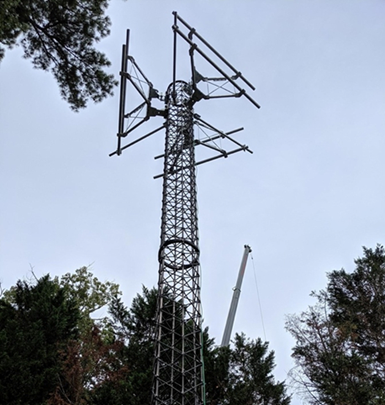IsoTruss receives USDA funding award for rural broadband project
Resilient composite mobile cell sites to provide more sustainable and versatile network access across rural locations.

Photo Credit: IsoTruss Inc.
IsoTruss Inc. (Springville, Utah, U.S.), an engineering, design, and manufacturing services provider, has received a funding award for $124,000 from the U.S. Department of Agriculture (USDA). In this rural broadband project, the enterprise expects to use its patented geometry to create a lightweight, composite space-saving mobile cell site to provide temporary network coverage, one that can be assembled and disassembled quickly, without additional equipment. The planned IsoTruss mobile cell site will save space, weigh less and last longer than current options.
“We are committed to help solve the digital divide in network coverage for nearly a quarter of rural Americans who are without broadband access,” Nathan D. Rich, CEO of IsoTruss Inc., says. “Expanding network coverage to them will improve rural community economies and quality of life, while providing access to important services such as telehealth, distance learning, ecommerce and remote work opportunities.
IsoTruss Inc. designs and manufactures patented composite lattice structures that are said to reduce weight by 12 times compared to steel structures, without compromising strength. These structures have been successfully applied to rural telecom towers because of their reduced weight and significantly lower installation and maintenance costs. A benefit of the mobile cell site is that it should be able to be transported with a light-duty truck, which enables greater access to rural and remote locations, and saves gas, which reduces emissions. This is the enterprise’s second funding award from the USDA.
IsoTruss lattice cell towers, fabricated with corrosion-resistant composites and using patented geometry, offer flexibility and modularity in structural design as well as optimized wind resistance, according to the company. IsoTruss towers are engineered and tested to last at least five times longer than steel towers, which need to be replaced more often due to corrosion and other environmental factors. Consequently, the total cost of ownership (TCO) is lower, and on the environmental side, carbon dioxide emissions are reduced by 70% or more over the tower’s lifespan.
“Lightweight, mobile cell sites can also provide network access quickly during natural disasters when existing networks are damaged. The space and weight savings of the IsoTruss will allow these mobile cell sites better transport and assembly in disaster-stricken areas,” Cromwell Wong, COO, IsoTruss Inc. adds. “Plus, our sustainable lattice tower infrastructure reduces CO2 emissions based on weight, material and design, making our cell towers very competitive with steel towers.”
Each IsoTruss cell tower is designed and manufactured to meet the firm’s own rigorous design and production standards, various local, state and federal regulations and Telecommunications Industry Association (TIA) and American Association of State Highway and Transportation Officials (AASHTO) standards.
Since 2019, IsoTruss Inc. has received multiple funding awards totaling nearly $1 million combined from both the U.S. Department of Agriculture (USDA), to support expansion of rural broadband, and the Environmental Protection Agency (EPA), for research and development of a reinforced concrete foundation for telecom towers to increase resiliency to natural disasters.
With a global portfolio of more than thirty patented and patent-pending structural and composite material designs that protect not only the configurations but also the manufacturing processes, IsoTruss is committed to building the sustainable infrastructure of the future through innovative solutions in engineering, design, manufacturing and construction.
The company is an active member of the Institute of Advanced Composites Manufacturing Innovation (IAMCI, Knoxville, Tenn., U.S.), a Manufacturing USA institute established by the U.S. Department of Energy (DOE). IACMI’s mission is to accelerate advanced composite design, manufacturing, technical innovation and workforce solutions to enable a cleaner and more sustainable, more secure and more competitive U.S. economy.
Related Content
Recycling end-of-life composite parts: New methods, markets
From infrastructure solutions to consumer products, Polish recycler Anmet and Netherlands-based researchers are developing new methods for repurposing wind turbine blades and other composite parts.
Read MoreWhy aren't composites synonymous with infrastructure?
The U.S. seems poised to invest heavily in infrastructure. Can the composites industry rise to the occasion?
Read MoreCarbon fiber in pressure vessels for hydrogen
The emerging H2 economy drives tank development for aircraft, ships and gas transport.
Read MoreThermoplastic composites welding advances for more sustainable airframes
Multiple demonstrators help various welding technologies approach TRL 6 in the quest for lighter weight, lower cost.
Read MoreRead Next
Covestro unveils thermoplastic polyurethane material for augmented 5G signal transmission
Desmopan 7000 TPU is characterized by high transparency for 5G frequencies for reduced signal loss, making it suitable for applications such as cell phones covers.
Read MoreIsotruss carbon fiber cell towers support global demand for 5G telecom rollout
Isotruss ramps up development of composite lattice cell towers which are twelve times stronger than steel towers, 1/12 their weight and reduce carbon emissions by 70%.
Read MoreComposites end markets: Energy (2024)
Composites are used widely in oil/gas, wind and other renewable energy applications. Despite market challenges, growth potential and innovation for composites continue.
Read More















.jpg;maxWidth=300;quality=90)










